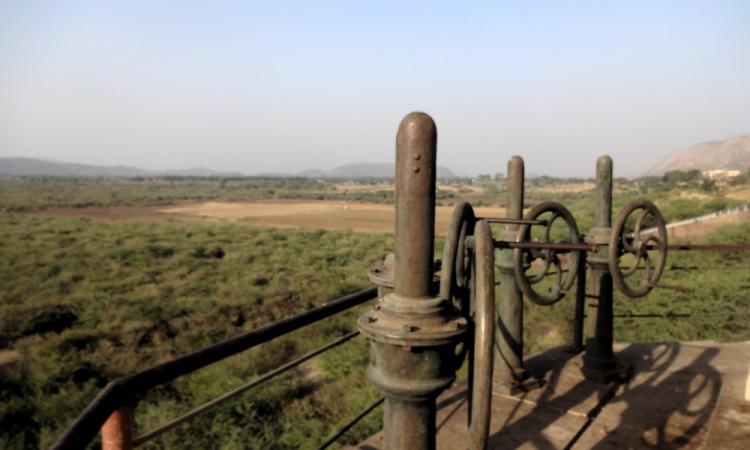
Last year, a crocodile walked seven kilometres to reach Jamwa Ramgarh village near Jaipur looking for food. It had ventured out from Jamwa Ramgarh dam, which used to have around 100 of its species at one time. Since 2006, however, the dam is dry, leaving little fish or other prey for the aquatic reptiles.
The dam was commissioned by Jaipur king Madho Singh II and got completed in 1903. But it started supplying water to the city only in 1931. Soon, the lake or the reservoir became a famous tourist spot and shot to international fame in 1982 when it hosted the rowing events of the Asian Games.
Today, however, the four rivers, Roda, Banganga, Tala and Madhoveni, which used to bring their water to the lake, have gone dry. After the Rajasthan high court took suo moto cognisance of the drying up of Ramgarh Lake in 2011, it was found that its catchment area, spread over 700 sq km, had as many as 405 anicuts and 800 encroachments ranging from farmhouses to education institutes.
Anicuts vs encroachments
Anicut is a cement wall erected perpendicular to the natural flow of a river or a stream. The excess water flows over the top of these walls while the water it can hold gradually seeps down the earth. These not only help meet the irrigation and water supply requirements in a decentralised manner but also recharge groundwater. Since 1990, Rajasthan, along with Gujarat, Madhya Pradesh and Maharashtra, has taken up intensive water harvesting through small structures like anicuts, ponds and check dams.
It was believed that the anicuts in the catchment area of Ramgarh Lake were having a negative downstream impact on the flow of streams and rivers. As the natural flow receded, Banganga and its tributaries turned fertile ground for encroachers.
“Many of the anicuts in the catchment area ranged from four to 10 metres in height. The high court directed the reduction in heights of the anicuts and removal of all encroachments so that the Ramgarh Lake could be restored to the 1982 status,” says advocate Virendra Dangi, who was a member of the monitoring committee to oversee implementation of the court order.
After the HC order, the anicuts, mostly owned by the Rajasthan Panchayati Raj Department, were reduced to a height of two metres, but it had little impact on the flow of rivers as encroachments have already obstructed their paths. Even after the construction of a 17-km-long canal linking Taala river to the Ramgarh Lake costing Rs 30 lakh, the water does not flow. “Anicuts can’t be held responsible for having greatly impacted such a large reservoir especially when these structures recharge groundwater which contributes to the surface flow of streams and rivers,” says Kunjbihari Sharma who has worked with people to revive Nanduwali river in neighbouring Alwar district.
The two-metre-height rule also seems arbitrary. The high court had taken reference from an earlier case, Abdul Rahman vs State of Rajasthan in which the court had directed dismantling of anicuts above the height of two metres. However, this case pertained to Nagaur district which is geographically and geologically different from the Aravalli hills of Jaipur.
“The technical specifications of anicuts and check dams need to take into account several factors like natural gradient of the land, average annual rainfall, rock formations, land use patterns and requirement of the locals etc. There can’t be a standard dimension for similar structures; they vary depending on the location,” says Dr Sunesh Sharma, a watershed management expert in Dehradun.
Narrow perspective on anicuts
There’s another purpose that anicuts serve which help downstream reservoirs. “These small obstructions reduce deposition of silt downstream and hence are very beneficial. The court looked at Ramgarh dam from the tourism and urban water supply perspective, but the needs of the rural areas met through anicuts were ignored,” says S. S. Grewal, the president of Society for Promotion and Conservation of Environment (SPACE), an organisation that has worked on water conservation in the area.
“The main reasons for drying up of rivers were deforestation and mining which is carried out in the catchment area. Action on anicuts was easy to implement and a good way to divert attention from these bigger issues. Unless we deal with these and remove the encroachments, the rivers and the reservoir will remain dry,” says Sharma.
The action on encroachments, however, has been lackadaisical. “Around 800 references of encroachments were sent to the revenue department for action but only 20 percent of these were removed. The NIMS University and Medical College, one of the biggest encroachers on the catchment area of Ramgarh Lake, is still standing despite the court giving full authority to the Jaipur Development Authority to take strict action. Similar is the case with other encroachers who enjoy political patronage,” says advocate Virendra Dangi.
Instead, costlier solutions are being explored. An announcement to link Brahmani, a tributary of Chambal river, with Ramgarh Lake was made in the state budget presented by former chief minister Ashok Gehlot. A feasibility report is now being prepared for the same. “Authorities have a narrow vision that looks at the lake as the only location to be rejuvenated. The rivers don’t end at Ramgarh, they travel beyond till Bharatpur. We need to tackle the core issues that impact the flow of these rivers than applying artificial solutions like lifting water from somewhere else,” say Sharma.